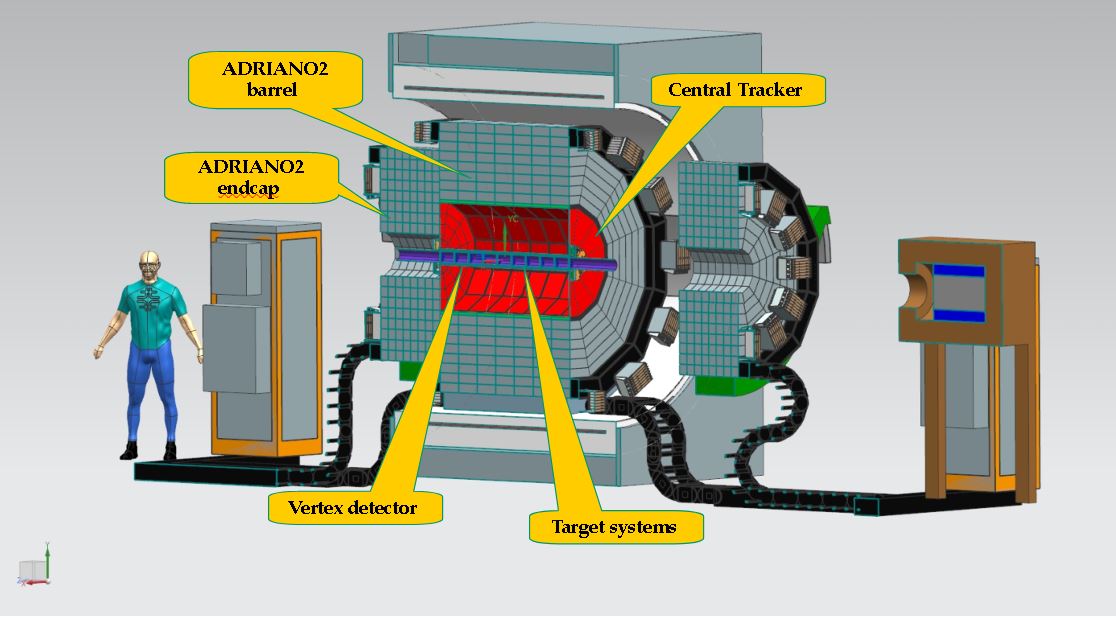The experiment
REDTOP is a proposed, low-energy, fixed-target meson factory. It belongs to the High-Intensity class of experiments, as it aims at detecting small variations from the Standard Model by studying a large sample of events produced with an intense beam. REDTOP scientists propose using a 1.8 GeV Continuous Wave (CW) proton beam impinging on a target made with 10 foils of a low-Z material (lithium or beryllium) to produce about 1014 η mesons in three years of running. The detector surrounding those targets will attempt to capture the decay products of the η mesons and, in particular, those that are either not expected or are suppressed up to the 10-11 level. η, η’ decays can produce light dark matter particles that the experiment can detect and more. Read a more detailed discussion of the physics processes of interest for REDTOP or the recent White Paper.
The beam
One of the most challenging aspects of REDTOP is related to the design of the proton beam required to produce the desired number of η/η’ mesons. The kinetic energy of that beam, in fact, needs to be high enough to generate the η mesons inside the target but, at the same time, not too high so that the background is kept at manageable levels. Monte Carlo simulations indicate that a beam energy of 1.8 GeV is optimal for the experiment. Furthermore, the beam time structure needs to be as uniform as possible, in order to allow the detector to collect, skim and transfer the information to the data storage.
Several laboratories could provide a proton beam with the specifications above. Three options are currently being explored:
Fermilab Delivery Ring
Fermilab is developing its new Muon Campus to provide beam for the Muon g-2 and Mu2e experiments. At center stage of the complex is the Delivery Ring (DR). For Muon g-2, 8 GeV protons will be targeted from the Main Injector/Recycler and the DR will be tuned to collect 3.1 GeV/c momentum muons. For Mu2e, the 8 GeV protons (8.9 GeV/c) will be transferred directly from the Recycler into the DR. The ring will have RF cavities for maintaining bunched beams as well as a slow resonant extraction system for use during Mu2e running. Though both Muon g-2 and Mu2e will run the DR at constant field, an additional RF cavity and improvements to the power supply system of the DR would allow the DR to decelerate beam to lower energies such as those required for REDTOP. Hence, such enhancements to the DR would open up a new realm of lower-energy, high rate experiments to augment the upcoming Muon program. Read a more detailed discussion of the accelerator complex for REDTOP.
GSI SIS18
The High-Energy Beam Lines (HEST) at GSI s a set of beam lines between SIS-18 synchrotron, ESR, Cryring storage rings and experiments, with a total length of about 600 meters. The proton beam can reach energies up to 2 GeV/u and intensities up to 1011 protons per spill. The beams are extracted from SIS-18 in both: slow and fast extraction modes. The extraction mode and the intensity available fullfil the beam requirements for REDTOP. In particular, the beamline optimized for the production of a secondary pion beam could be used for the production of η mesons on REDTOP target systems. The residual proton beam (approximately 99% of the primary protons) could be transported to the pion target to run the pion program at GSI.
HIAF Multi-terminal
The heart of HIAF accelerator complex is a Booster Ring delivering protons or ions to several extraction halls (Terminals). The Multi-function terminal can easily accommodate the REDTOP detector. The beam at that terminal could reach an energy above 9 GeV and an intensity exceeding 1013 protons per second, about two orders of magnitude higher than required. The structure of the beam can be adapted to REDTOP by a slow-extraction method with a long top-off, making it very close to a CW beam.
The detector
As is usually the case with High Precision experiments, the rare processes that the scientists want to study are accompanied by a large number of background events that can potentially hide or mimic those of interest.
Therefore, in order to keep the background at tolerable levels, the detector must be very fast and sensitive only to those particles expected to be produced in the processes of interest, namely electrons, positrons, muons and photons. This is why the whole apparatus is based on the detection of prompt Cerenkov light, which is promptly created while the background particles (essentially, all the hadrons) are mostly under the Cerenkov threshold. Read a more detailed discussion of REDTOP detector.
The science program
The detector being designed for the REDTOP experiment will exploit novel technologies aimed at a highly granular, nearly hermetic apparatus, with fast timing (~30 psec) and excellent particle identification. This will enhance the sensitivity of the experiment to a rich and broad physics program, exploiting different beam energies and beam configurations. The physics opportunities offered by an η/η’ factory have been discussed in great detail the White Paper and are summarized on the physics program page. The runs planned for REDTOP are described at the following link.
However, more experiments could be envisaged with eventual modifications or upgrades of the detector. These will encompass runs with muons or kaon beams and with different targets. The high granularity of the calorimeter could be exploited at an EDM experiment, as the inelastic events, diluting the EDM measurement, would be rejected with a larger efficiency than with a more conventional polarimeter.
